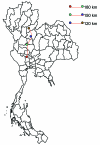Domestic ducks and H5N1 influenza epidemic, Thailand
- PMID: 16704804
- PMCID: PMC3294714
- DOI: 10.3201/eid1204.051614
Domestic ducks and H5N1 influenza epidemic, Thailand
Abstract
In addition to causing 12 human deaths and 17 cases of human infection, the 2004 outbreak of H5N1 influenza virus in Thailand resulted in the death or slaughter of 60 million domestic fowl and the disruption of poultry production and trade. After domestic ducks were recognized as silent carriers of H5N1 influenza virus, government teams went into every village to cull flocks in which virus was detected; these team efforts markedly reduced H5N1 infection. Here we examine the pathobiology and epidemiology of H5N1 influenza virus in the 4 systems of duck raising used in Thailand in 2004. No influenza viruses were detected in ducks raised in "closed" houses with high biosecurity. However, H5N1 influenza virus was prevalent among ducks raised in "open" houses, free-ranging (grazing) ducks, and backyard ducks.
Figures




References
-
- Tang X, Tian G, Zhao C, Zhou J. Isolation and characterization of prevalent strains of avian influenza viruses in China [in Chinese]. Chinese J Anim Poultry Infect Dis. 1998;20:1:5.
-
- Sims LD, Domenech J, Benigno C, Kahn S, Kamata A, Lubroth J, et al. Origin and evolution of highly pathogenic H5N1 avian influenza in Asia. Vet Rec. 2005;157:159–64. - PubMed
Publication types
MeSH terms
Grants and funding
LinkOut - more resources
Full Text Sources
Medical
